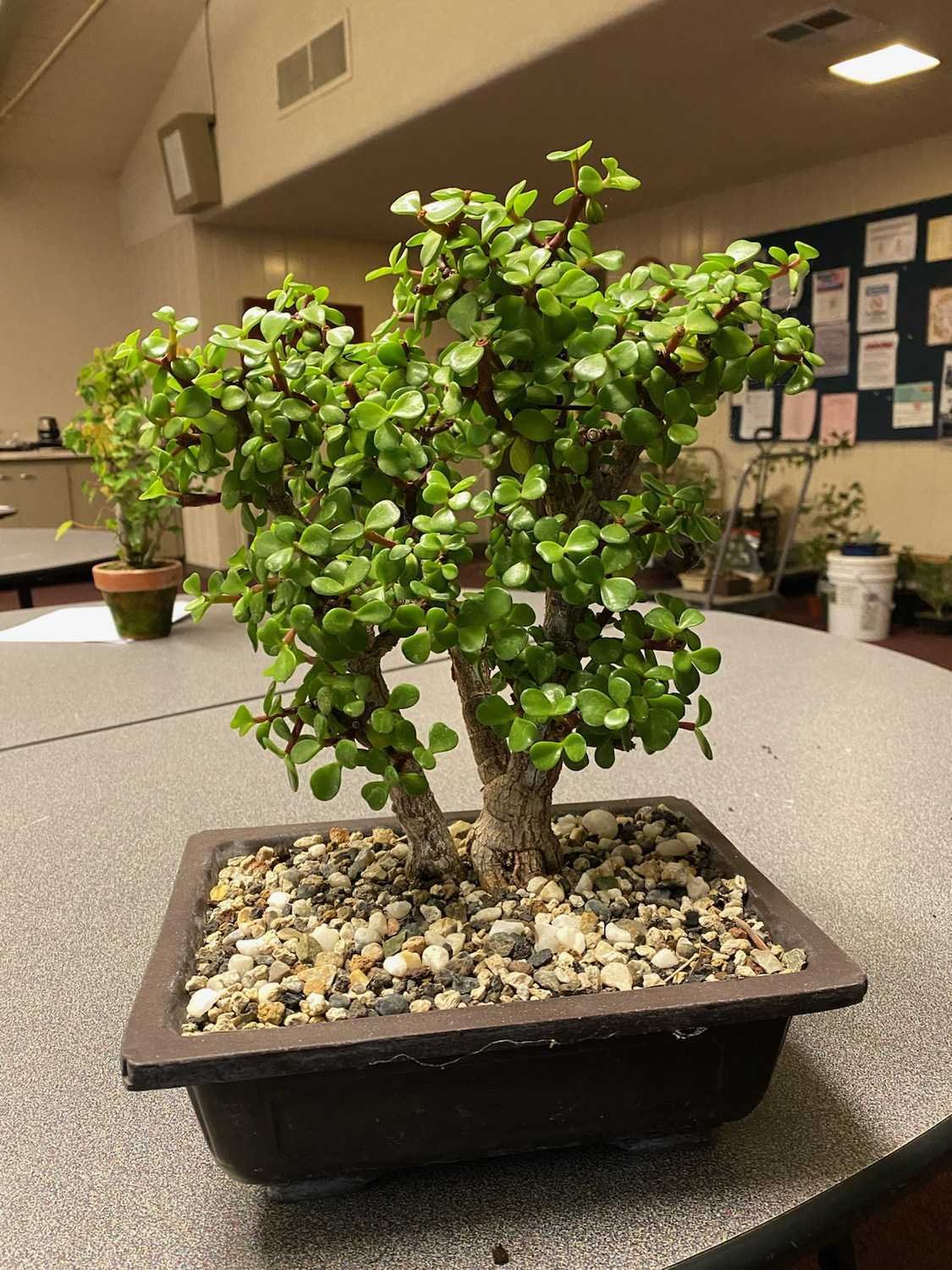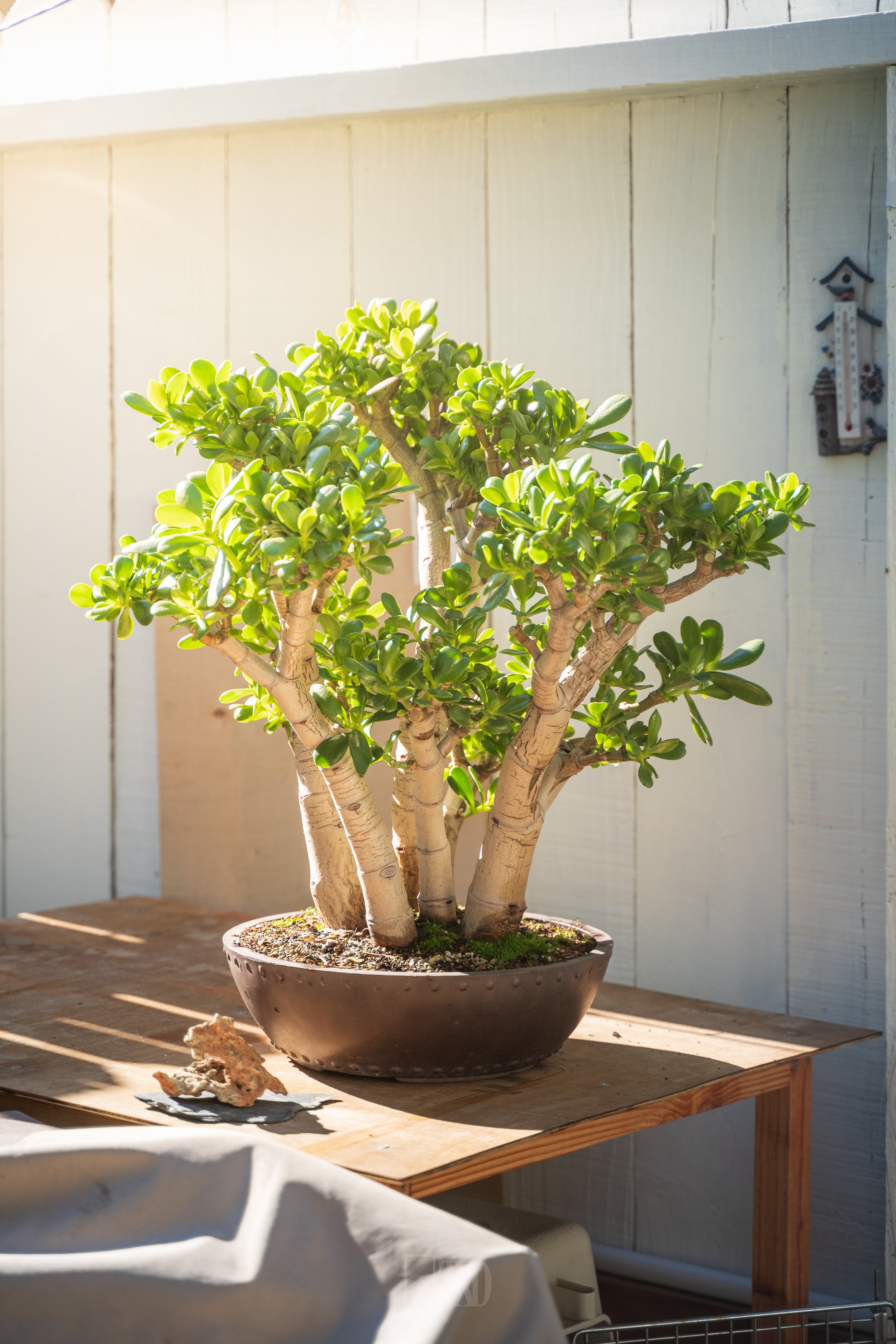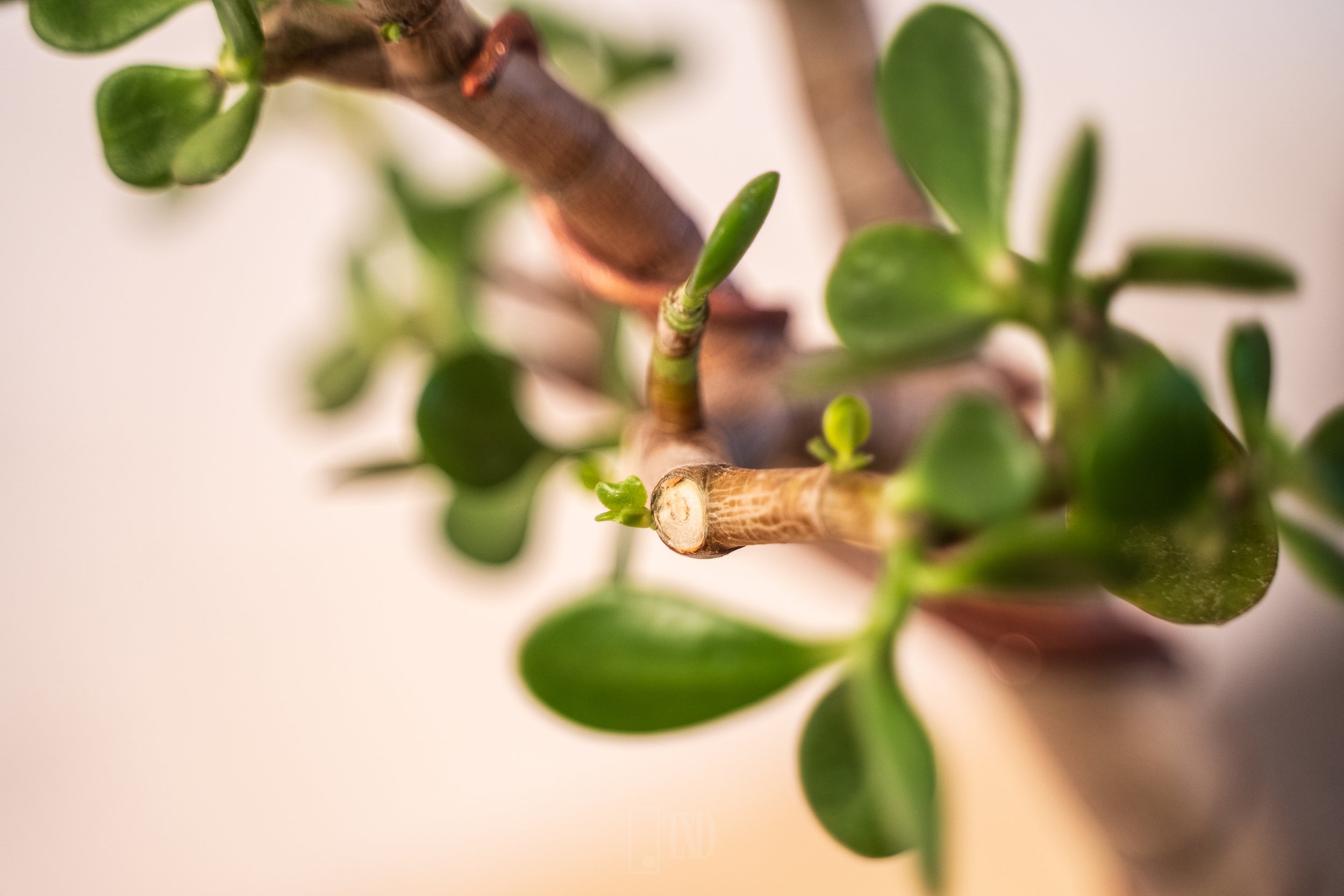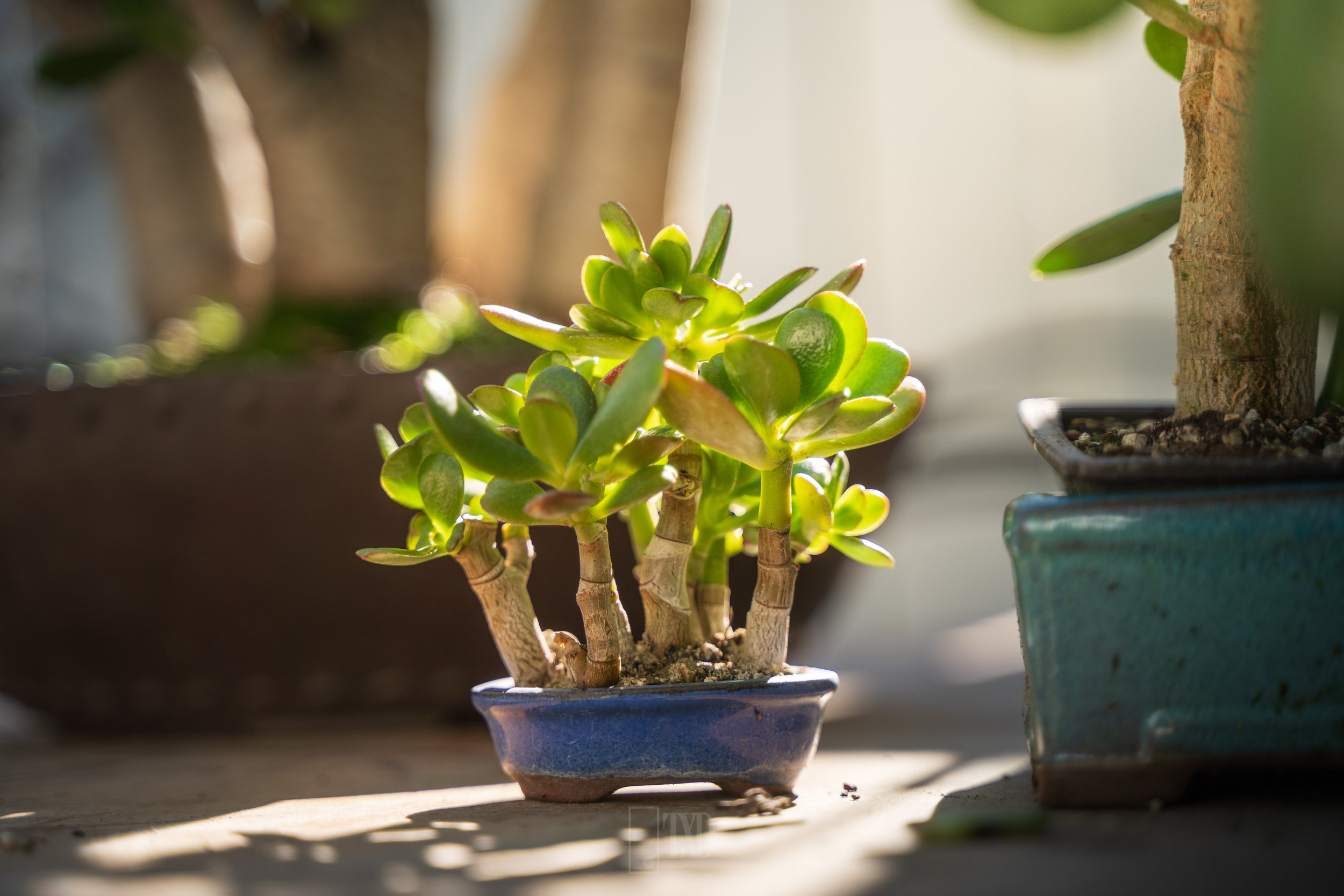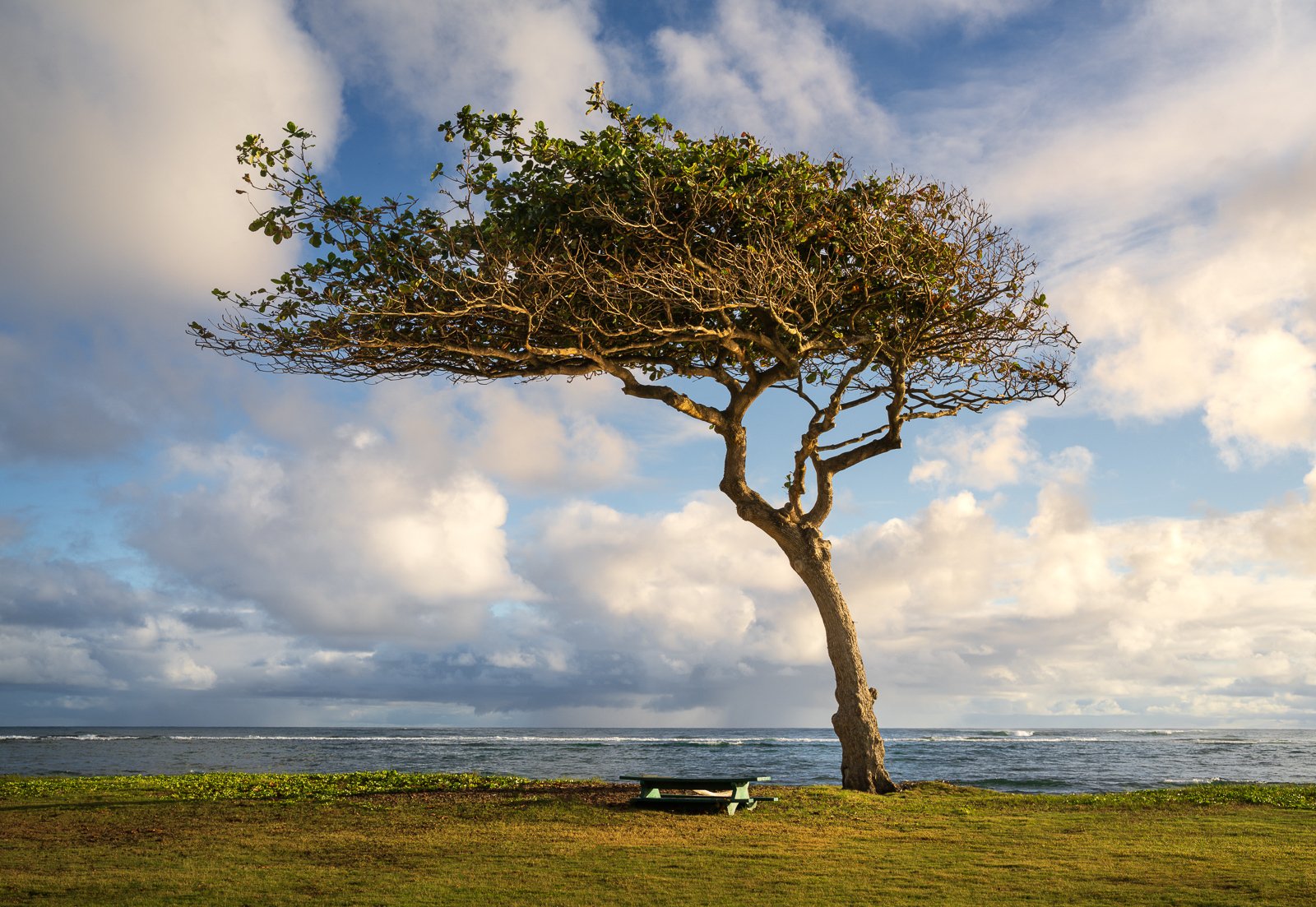Rope ’em in With Jade Plant
A friend of mine decides one day to get into bonsai. She had seen my bonsai collection and was quite impressed. The Midori Silent Auction is coming up, so I tell her that this would be a great opportunity to get some starter material. She is ecstatic at the chance to get into bonsai.
I ask a little bit about her gardening experience. She says she is just starting out; it’s something she wished she knew more about. She has some succulents and that was all she could keep alive. I ask if she will be able to water a bonsai tree every day.
“No, I travel for a week from time to time, and I don’t have anyone to water for me.”
I cross off a lot of trees in my head. I ask about tools. Nope, nothing beyond a basic garden shear, if even that. Wire? Hah! As you can tell, she is very new to this.
“Ok, great! I’ll see what I can find for you.” Oh boy, what did I get myself into?
The P. afra I got for my friend from the Silent Auction.
As luck would have it, I find the perfect tree for her at the auction — much thanks to Elliott! He brought in a wonderful selection of jades (specifically Portulacaria afra, or dwarf jade). One of them is even already on its way to becoming a nice tree. I give my friend this one, and I decide to keep the other ones for my own collection.
An Excellent Beginner’s Tree
A jade plant group planting shows the dense foliage that is possible with a little training.
Crassula ovata (jade plant) and P. afra (dwarf jade plant) are succulents from South Africa commonly grown in both indoor and outdoor settings. They have smooth oval leaves that grow in pairs on the stem. The leaves can turn red under the right conditions. They also create beautiful white and/or pink flowers.
Experienced bonsai practitioners know the difficulty of the maintenance and upkeep that we put into our trees. They’re babies that can’t tell you if something is wrong. It would be so disheartening to a beginner to have to undertake a huge responsibility with so little experience, only to have the tree die.
While the tree I got for my friend is a P. afra (dwarf jade with small succulent leaves), I primarily grow C. ovata (the larger leafed cousin) and will be discussing about why these make excellent beginner trees. They have very forgiving watering requirements, are very easy to prune, tolerate a wide range of lighting, and lend themselves very well to training. I believe the reasons do carry over quite well to P. afra — just keep in mind that my experience comes mainly from growing crassula-type jades.
Because of the easy care requirements, I think jade plant is possibly an even better beginner’s bonsai tree than a juniper mallsai. We are all familiar with these. They have skinny trunks and can be found at any garden center — or shopping malls. It is not to say that we should eschew mallsai; they are responsible for a lot of laypeople getting into bonsai and should be celebrated in their own right.
Watering
Jade plant can tolerate a wide amount of watering.
For a beginner, the watering requirements don’t get easier than jade. It can tolerate everything from just rain water in the winter to being watered like any other bonsai. In my garden, I water my jades the same as I would my other trees. I’ve also seen jades that get neglected except for when the rain pours in the winter. Both do fine. In fact, the neglected one displayed more color in the form of red stripes on the leaves.
I grow mine in regular bonsai mix, but I’ve seen it growing in all sorts of different soils — from potting mix to ground soil to other esoteric mixes. You definitely don’t want the water to collect and rot the roots away, so make sure the pot has a hole.
Because of this, people who haven’t gotten into — or can’t do — the proper routine of checking every day and watering as needed can have a better chance at keeping something alive.
Pruning
Jade lends itself well to pruning. Or not pruning. You can prune it a lot, or not at all. You’ve probably seen jade bushes that grow in front yards with minimal work. They grow into compact bushes with lots of ramification and thick trunks. I often see them in pots outdoors. They do tend to get a little leggy and sparse in these situations.
Jade plant easily and predictably back-buds with pruning. If the plant is left outdoors for the winter, don’t prune in the fall before the rain comes, however, because the wounds can rot.
That’s ok, because pruning doesn’t require any special tools. And because they’re succulents, you could use household scissors and cut right through the soft branches. If you’re a beginner and have no tools yet, this is great. (Please do get proper tools once you really get into this hobby, of course!)
Another great thing about pruning jades is that they backbud very reliably and predictably. Wherever I prune, I can almost always expect two buds to pop out at the cut. Developing ramification is not an issue with jade.
Lighting
Jade can grow anywhere that the temperature doesn’t drop much below freezing. Ideally, they would be grown in as much sunlight outdoors as they can get (except in very hot climates). This leads to very vigorous and dense growth. However, if all you have is a table indoors, it’ll grow there too. It’s as though it doesn’t care!
Of course, it’s not as ideal to grow in very low light conditions. It tends to get leggy if left unpruned indoors.
They Look Nice
This single trunk jade plant needed an emergency repot due to wind damage. It is in the process of light wiring after pruning.
Content warning — falling trees and broken pots!
I currently have a jade in development indoors. It was originally in a terra cotta pot with an inappropriately small base. Of course, it fell over in the wind and broke the pot, requiring an emergency repot. A few branches also got broken off. As a result, I had to repot it into a proper bonsai pot and let it heal indoors. If left outside, the constant moisture from the rain will cause the cuts to rot and branches will be lost. I know this from experience on another jade. After repotting, it’s been sitting inside for a few weeks now. I wired and pruned it since it will be indoors for the winter. Only a week or so later, the cuts are popping out new buds everywhere.
Some important qualities that we look for in bonsai material are trunk size, trunk character, and good nebari. I think jade fulfills these requirements to a pretty good extent. It may be an unconventional species for bonsai, but it exhibits many of these desirable qualities for bonsai. Plus, as a bonus, it’s great for anyone, including beginners, who wants a forgiving tree to take care of.
“It may be an unconventional species for bonsai, but it exhibits many desirable qualities.”
There’s a certain thing to be said for size. Bigger trees tend to be easier to take care of. Jades with thick trunks are easy to come by. If you can’t find one, they grow thick pretty quickly from a cutting (which can be thick already). Or even a leaf. Just let it grow undistrubed for a few years and they should thicken fast.
They can be grown in many of the classical styles. I have a large group planting, a single trunk informal upright, and a mame size group planting. Some of the weird skinny ones I’ve seen outside dental offices would make interesting literati style. I’ve seen really fat trunks growing in my neighbors’ yards. I can tell they do practically nothing to maintain them, and — with a little bit of training — would make wonderful trees.
The bark can become flaky and aged if there is vigorous growth.
The bark does get very interesting. My group planting jade’s bark is starting to split as the trunk and branches get fatter. For P. afra, the bark is naturally more wrinkly, adding to the aged appearance. This is in contrast to crassulas which tend to have a younger, more round bark.
The nebari can be quite nice. Jade does make a good nebari when it’s trained to do so. Just do the same as you would for a normal bonsai.
All things considered, I think we have a great beginner’s tree. It’s easy to water for a wide variety of schedules, it’s easy to maintain and develop, and once you train it you get a handsome tree with a lot of the distinguishing features that make a bonsai. If you know someone who wants to get into bonsai, but doesn’t have the skills, tools, or ability to fully commit to the rigors of traditional bonsai, consider giving them a jade. Hopefully, this will become that seminal event that sparks the fire that leads them into the world of bonsai. 🌳
Jade plant can be grown in a variety of styles and sizes. Here, a mame forest planting is shown with the larger group planting in the background.
Trees in the Wild
Image and Story by Jeff Lewis
When I was younger, I would spend a few weeks every year in Hawaii with my family. I didn't really take note of the trees there; I remembered lots of palm trees on the beach and a couple large banyans. When Tung and I went back for our own vacation, all that changed. We were stunned by the beauty of the trees growing everywhere. In fact, on our first trip, we thought someone had to be pruning all the tamarind trees, because they were so perfect! Turns out they just grow naturally with a perfect trunk and canopy. Our drives around the island took quite some time, with all the tree oogling and photo stops.
Anyway, I was driving back from a sunrise photoshoot up the road, and this tree caught my eye. It looked so perfect, standing tall over a picnic table. The clouds and light were perfect, too! I pulled over and ran onto this grassy lawn to take a photo. A few moments later, the clouds drifted past and the best light was gone. Next time we're around, we'll have to enjoy a picnic on that table -- just looking at it evokes such a peaceful feeling for me. 🌳
Upcoming Midori Events
December — Holiday Dinner and Auction
Our much beloved holiday dinner is scheduled to take place on the First Thursday of December. It will be followed by a live auction and the election of next year’s officers.
December — developing next year’s program
Once again, we ask all club officials and those who have ideas for future programing to please attend the meeting scheduled for Monday, December 13th. We will be meeting at Armadillo Willy’s restaurant at the Camden Park Shopping Center on the corner of Union Ave and Camden, only three blocks from our church facility meeting place.
We will all meet between 5:30 and 6:00pm at the restaurant, eating first and then starting the meeting.
As always, the Third Thursdays are our general workshop. Bring in some trees to work on or get feedback. 🌳
Upcoming Northern California (and Beyond) Bonsai Events
EAST BAY BONSAI SOCIETY BONSAI SALE
Saturday, January 8th, 2022, 10:00 am - 3:00 pm
Oakland Lakeside Garden Center
666 Bellevue Avenue, Oakland, California
Join us for our in-person January 2022 club sale! The East Bay Bonsai Society will be holding a one-day bonsai sale on Saturday, January 8th, 2022 from 10am to 3pm at the Lakeside Garden Center in Oakland, California.
The sale will include established and starter bonsai trees, pots, tools, etc. Masks are required. Credit cards, checks, and cash accepted. Sales tax will be added to purchases.
Point of Contact is Lisa Harper at lisaharper@me.com.
18TH BIENNIAL SHOHIN SEMINAR
FEBRUARY 4, 5, AND 6, 2022
Hotel Mission de Oro
Registration begins November 1st, 2021. This is a fantastic opportunity that comes only once every two years.
For more information, please visit https://www.calshohin.org/.
21ST ANNUAL MAMMOTH AUCTION AND SALE
FEBRUARY 19 AND 20, 2022
Lakeside Park and Garden Center, Oakland, CA
The annual Bonsai Garden at Lake Merritt Mammoth Auction and Sale will be held on Saturday, February 19 and Sunday, February 20, 2022 at 666 Bellevue Ave., Lakeside Park Garden Center in Oakland. You are invited to the biggest auction and sale of bonsai, pre-bonsai, pots, books, stands, and related material. A Mammoth fundraiser with all proceeds going to support the Bonsai Garden at Lake Merritt (BGLM).
For more information, please visit the event page.

